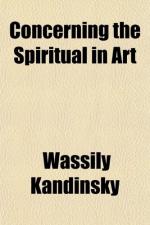If the artist be priest of beauty, nevertheless this beauty is to be sought only according to the principle of the inner need, and can be measured only according to the size and intensity of that need.
That is beautiful which is produced by the inner need, which springs from the soul.
Maeterlinck, one of the first warriors, one of the first modern artists of the soul, says: “There is nothing on earth so curious for beauty or so absorbent of it, as a soul. For that reason few mortal souls withstand the leadership of a soul which gives to them beauty.” [Footnote: De la beaute interieure.]
And this property of the soul is the oil, which facilitates the slow, scarcely visible but irresistible movement of the triangle, onwards and upwards.
IX. CONCLUSION
The first five illustrations in this book show the course of constructive effort in painting. This effort falls into two divisions:
(1) Simple composition, which is regulated according to an obvious and simple form. This kind of composition I call the melodic.
(2) Complex composition, consisting of various forms, subjected more or less completely to a principal form. Probably the principal form may be hard to grasp outwardly, and for that reason possessed of a strong inner value. This kind of composition I call the symphonic.
Between the two lie various transitional forms, in which the melodic principle predominates. The history of the development is closely parallel to that of music.
If, in considering an example of melodic composition, one forgets the material aspect and probes down into the artistic reason of the whole, one finds primitive geometrical forms or an arrangement of simple lines which help toward a common motion. This common motion is echoed by various sections and may be varied by a single line or form. Such isolated variations serve different purposes. For instance, they may act as a sudden check, or to use a musical term, a “fermata.” [Footnote: E.g., the Ravenna mosaic which, in the main, forms a triangle. The upright figures lean proportionately to the triangle. The outstretched arm and door-curtain are the “fermate.”] Each form which goes to make up the composition has a simple inner value, which has in its turn a melody. For this reason I call the composition melodic. By the agency of Cezanne and later of Hodler [Footnote: English readers may roughly parallel Hodler with Augustus John for purposes of the argument.—M.T.H.S.] this kind of composition won new life, and earned the name of “rhythmic.” The limitations of the term “rhythmic” are obvious. In music and nature each manifestation has a rhythm of its own, so also in painting. In nature this rhythm is often not clear to us, because its purpose is not clear to us. We then speak of it as unrhythmic. So the terms rhythmic and unrhythmic are purely conventional, as also are harmony and discord, which have no actual existence. [Footnote: As an example of plain melodic construction with a plain rhythm, Cezanne’s “Bathing Women” is given in this book.]




